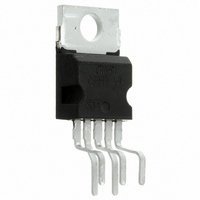TDA2030AV STMicroelectronics, TDA2030AV Datasheet - Page 11

TDA2030AV
Manufacturer Part Number
TDA2030AV
Description
IC AMP AUDIO 18W MONO PENTAWATT5
Manufacturer
STMicroelectronics
Type
Class ABr
Specifications of TDA2030AV
Output Type
1-Channel (Mono)
Max Output Power X Channels @ Load
18W x 1 @ 4 Ohm
Voltage - Supply
12 V ~ 44 V, ±6 V ~ 22 V
Features
Short-Circuit and Thermal Protection
Mounting Type
Through Hole
Package / Case
Pentawatt-5 (Vertical, Bent and Staggered Leads)
Product
Class-AB
Output Power
18 W
Available Set Gain
80 dB
Thd Plus Noise
0.5 %
Operating Supply Voltage
22 V
Supply Current
80 mA
Maximum Power Dissipation
20000 mW
Maximum Operating Temperature
+ 150 C
Mounting Style
Through Hole
Audio Load Resistance
8 Ohms
Dual Supply Voltage
+/- 9 V, +/- 12 V, +/- 15 V, +/- 18 V
Input Bias Current (max)
2 uA
Input Offset Voltage
15 V
Input Signal Type
Differential
Minimum Operating Temperature
- 40 C
Output Signal Type
Single
Supply Type
Dual
Amplifier Type
MIC
Bandwidth
100 MHz
Current, Input Bias
0.2 μA
Current, Input Offset
±20 nA
Current, Output
3.5 A
Current, Supply
50 mA
Harmonic Distortion
0.08 %
Impedance, Thermal
3 °C/W
Open Loop Gain
80
Package Type
Pentawatt
Power Dissipation
20 W
Resistance, Input
5 Megohms
Slew Rate
8
Voltage, Input
±22 V
Voltage, Input Offset
±2 mV
Voltage, Noise
3 μV
Voltage, Supply
±6 to ±22 V
Amplifier Class
AB
No. Of Channels
1
Supply Voltage Range
± 6V To ± 22V
Load Impedance
4ohm
Operating Temperature Range
-50°C To +150°C
Amplifier Case Style
Pentawatt V
Rohs Compliant
Yes
Lead Free Status / RoHS Status
Lead free / RoHS Compliant
Other names
497-2165-5
Available stocks
Company
Part Number
Manufacturer
Quantity
Price
Company:
Part Number:
TDA2030AV
Manufacturer:
ST
Quantity:
100 000
Company:
Part Number:
TDA2030AV
Manufacturer:
ST
Quantity:
12 000
Part Number:
TDA2030AV
Manufacturer:
ST
Quantity:
20 000
MUSICAL INSTRUMENTS AMPLIFIERS
Another important field of application for active
systems is music.
In this area the use of several medium power
amplifiers is more convenient than a single high
power amplifier, and it is also more realiable.
A typical example (see Figure 21) consist of four
amplifiers each driving a low-cost, 12 inch loud-
speaker. This application can supply 80 to
160W
Figure 21 : High Power Active Box
TRANSIENT INTERMODULATION DISTOR-
TION (TIM)
Transient intermodulation distortion is an unfortu-
nate phenomen associated with negative-feedback
amplifiers. When a feedback amplifier receives an
input signal which rises very steeply, i.e. contains
high-frequency components, the feedback can ar-
rive too late so that the amplifiers overloads and a
burst of intermodulation distortion will be produced
as in Figure 22. Since transients occur frequently
in music this obviously a problem for the designer
of audio amplifiers. Unfortunately, heavy negative
feedback is frequency used to reduce the total
harmonic distortion of an amplifier, which tends to
aggravate the transient intermodulation (TIM situ-
ation. The best known method for the measurement
of TIM consists of feeding sine waves superim-
posed onto square waves, into the amplifier under
test. The output spectrum is then examined using
a spectrum analyser and compared to the input.
This method suffers from serious disadvantages :
the accuracy is limited, the measurement is a rather
delicate operation and an expensive spectrum an-
alyser is essential. A new approach (see Technical
Note 143) applied by SGS-THOMSON to mono-
lithic amplifiers measurement is fast cheap-it re-
quires nothing more sophisticated than an
oscilloscope - and sensitive - and it can be used
RMS
.
for Musical Instrument
down to the values as low as 0.002% in high power
amplifiers.
Figure 22 : Overshoot Phenomenon in Feedback
The "inverting-sawtooh" method of measurement
is based on the response of an amplifier to a 20kHz
sawtooth waveform. The amplifier has no difficulty
following the slow ramp but it cannot follow the fast
edge. The output will follow the upper line in Fig-
ure 23 cutting of the shaded area and thus increas-
ing the mean level. If this output signal is filtered to
remove the sawtooth, direct voltage remains which
indicates the amount of TIM distortion, although it
is difficult to measure because it is indistinguish-
able from the DC offset of the amplifier. This prob-
lem is neatly avoided in the IS-TIM method by
periodically inverting the sawtooth waveform at a
low audio frequency as shown in Figure 24.
Figure 23 : 20kHz Sawtooth Waveform
Figure 24 : Inverting Sawtooth Waveform
Amplifiers
TDA2030A
11/15








